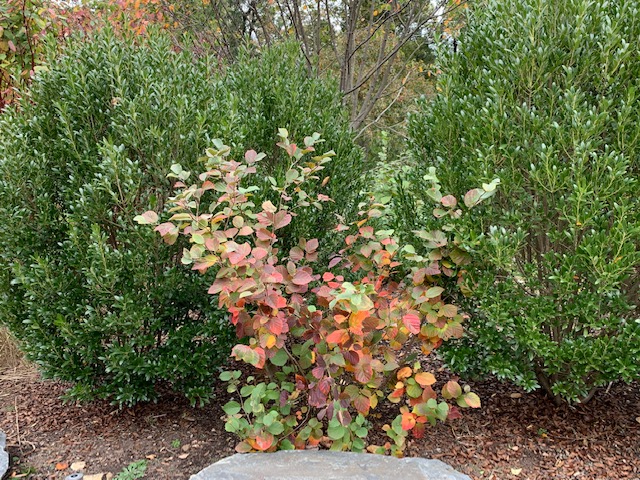Specifically, oh Fothergilla gardenii, where art thou? And where all the other really interesting native shrubs?
Why is it, we wonder, that a walk through any Westchester neighborhood reveals the same repetitive collection of uninteresting plants? Yard after yard, and in every park and golf course and commercial zone, we see the same boring plants: forsythia, burning bush, taxus, barberry, boxwood. Worse, none of these plants are native to North America, so they have no value to wildlife. And much worse, some of them are incredibly invasive, taking over forests and replacing native plants essential to biodiversity.
Even if that weren’t a priority, wouldn’t it just be fun to have shrubs you don’t see in every yard on your street? And shouldn’t we want plants in our landscape that are interesting for more than two weeks a year?
Forsythia blooms in early spring, but does nothing interesting in summer or fall. Burning bush turns red in the fall, but does nothing interesting in spring or summer, and it’s so invasive that its sale is now regulated or banned in New York and other states.
Dwarf Fothergilla, on the other hand, is a gorgeous native shrub with three seasons of interest. It blooms in early spring, and unlike forsythia, its flowers are fragrant – they smell like honey! And they attract and nourish pollinators.

All summer long, Fothergilla catches the eye with pretty bluish-green, rounded leaves. It can be used as a hedge, but rarely needs trimming. It tops out around 4 feet and naturally maintains a rounded shape. It is not vulnerable to disease and needs no regular maintenance. It may need supplemental water in periods of drought, but it does not need fertilizer.


In fall, Fothergilla is nothing short of spectacular, especially if it is planted in full sun. To really show it off, you can plant it in front of evergreens. At the Nature Center, we have it in front of the native Inkberry (Ilex glabra), where it stands out as a specimen shrub in all three seasons. You can find it on the patio in front of the Manor House at the top of the stairs.



Check back next week to learn about other “not-boring” native shrubs!
This blog is authored weekly by Cathy Ludden, local expert and advocate for native plants; and Board Member, Greenburgh Nature Center. Follow Cathy on Instagram for more photos and gardening tips @cathyludden.


Wow! How did I not know about this plant? Or if I did, forgot. I immediately googled to see if deer resistant and was thrilled that it is at least “reported” to be deer resistant. Also, glad that it stays small. Will try it in a perennial border where I am trying to put more shrubs for less maintenance. Thanks, Cathy.
I have not seen deer browse Fothergilla, either at the Nature Center or my own garden. No guarantees if they get very hungry, but definitely worth a try, Sandy!
Thanks for reminding me of this plant. Had this at a former home and will definitely find a spot for it in my yard.
You won’t be sorry! It’s a beaut!
I have planted lots of them on local golf courses. And homes too. I love them! Great post Cathy.
Thanks, Elaine. Fothergilla makes a great hedge also. I would love to see it used more often.